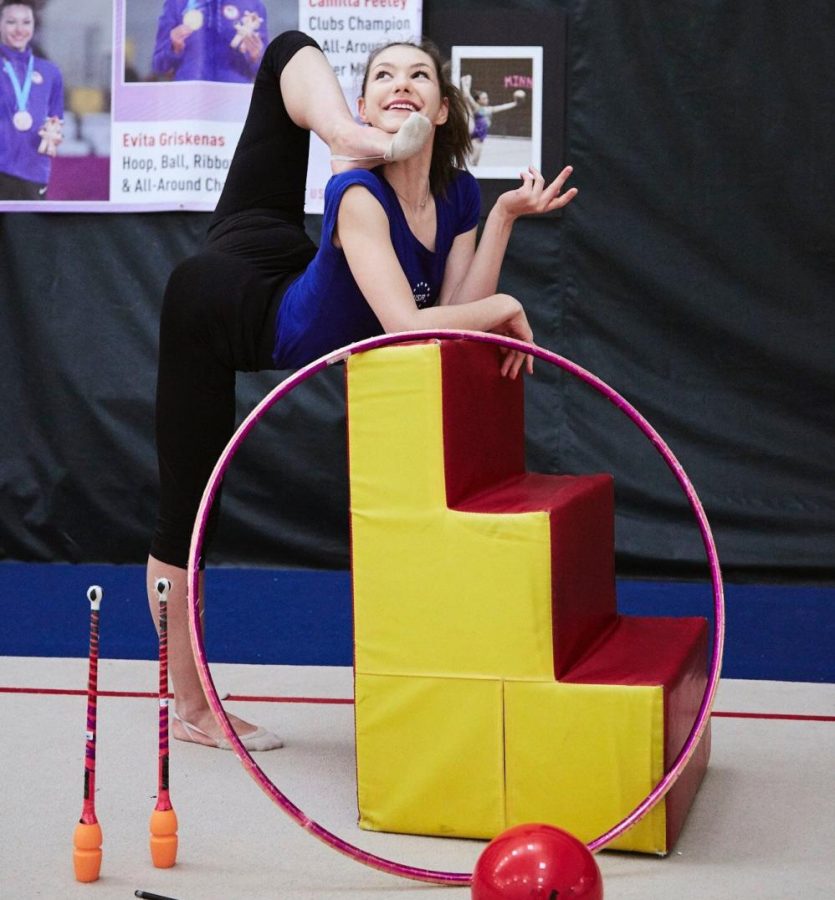TALES OF A TRAVELING HOOP ( . . . or how a US Olympic gymnast flies to the Summer Games in Tokyo)
Evita Griskenas, of the US Olympic gymnastics team, poses with some some of the apparatuses she performs with, including the ball, clubs, and hoop.
July 16, 2021
“Is that… a satellite dish? Bicycle tire? Wait no … it’s a trampoline! Right?”
When we rhythmic gymnasts travel, all of our equipment comes with us. As checked luggage can (and has) been lost before, our neatly folded leotards, carefully rolled-up ribbons, mildly deflated ball, and tactfully placed clubs are all packed into a carry-on bag, taken into the plane, and placed into an overhead compartment.
But . . . what happens with the hoops?
Ranging from 75-90 centimeters in diameter, the hoops are made of a relatively flexible plastic that can be easily bent out of shape if casually thrown in with normal luggage. Thus, it is most preferable that our hoops are carried onto the plane as an additional piece of allotted, carry-on luggage. And while sometimes airline companies will deny our attempts and make us pay for the hoops as additional, oversized, check-in baggage (fingers crossed they don’t get squished!), most airlines are quite nice about it (if not slightly confused).
That said, let me take you through the process of traveling with a hoop:
First, we need to pass through the check in counter and be as nonchalant as possible. The less attention the hoops get, the better.
Next: TSA. Upon reaching the scanning counters, the agents begin visually comparing the hoop sizes to the X-ray machine opening and greet us with inquizitive looks. Noting that they will not fit (Yes, we do get asked if we can fold the hoops. No, we cannot fold the hoops), we politely ask for them to be hand checked — a process in which the TSA agents visually inspect the hoops and swab them with little disposable white cloths to ensure that they are explosive free before sending us off on our merry ways.
And, after getting many fun stares and a handful of questions and guesses as to what the hoops are (trampoline is the most common guesstimate), we finally get to board the plane!
This then, can go one of two ways: gate-checking or carry on.
Gate-checking is a service that allows passengers to take their oversized, yet necessary, items (like strollers) through the airport before tagging the items at the gate during boarding so that they could be stowed under the plane. Then, the items are either retrieved at an oversized luggage counter or the jet bridge of the plane itself. But, more often than not, we are simply allowed to bring them onboard.
Now, here is the fun part: Once we get on the plane, there are a few options. Most commonly, the hoops are put behind the last row of seats. For long-haul plane rides, the hoops fit perfectly into the closet spaces that can be found onboard. But if those are too small or nonexistent, we also have the option to either seat-belt them in an empty row or to ourselves. (Very rarely, and often as a last resort, we can also squeeze the hoops in the gap between the plane seat and window!)
And well… there you have it: a short summary of how rhythmic gymnasts travel with their hoops.
Of course, this summary excludes common commentaries of: “Hey wait up, my hoop is sliding off of my shoulder again while my hands are occupied,” the polite, “Yup, I do know how to hula-hoop,” and the “Oh guys wait! I forgot my hoop at security!”
Alas, I’m also not one to complain. Though traveling with a hoop may make us jump through a few extra hoops, knowing I will be using them to represent the United States in the international arena makes it all worthwhile.
(Evita Griskenas is a student at Columbia University and a member of the US Olympic gymnastics team, and will soon be competing in the Summer Games in Tokyo.)
–July 16, 2021–

























Lida Yellin • Jul 20, 2021 at 10:25 am
I love Evita and I enjoyed the story! As a gymnast who never competed abroad it was nice to learn about the traveling process I never experienced. My fingers are crossed for the US, best of luck 🙂